Biogas
Welcome to Dickinson College Farm Biogas!
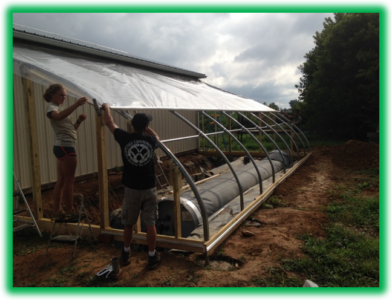
The current biogas digester, under construction (2015)
What is Biogas?
Biogas digestion converts organic wastes into burnable methane gas, a versatile energy source for cooking, heating, and electricity generation. Since 2008, the College Farm has been experimenting with demonstration-scale biogas systems and laboratory research projects. Altogether this work includes numerous student projects, lab exercises, youth education programs, video and conference presentations resulting in international recognition for sustainability at Dickinson. Gas generated by the biogas digesters is used on the farm to fuel cooking appliances. In the near future, we will complete a farm-scale digester that will convert biogas to electricity and wipe out the farms power bill. Use of biogas on the farm replaces propane and other fossil fuels thereby contributing to the farm and College’s goal of net reduction of carbon emissions.
Table of Contents:
Current Initiatives |
Videos |
Papers and Articles |
Commercial Digester Updates |
Commercial Digester Development
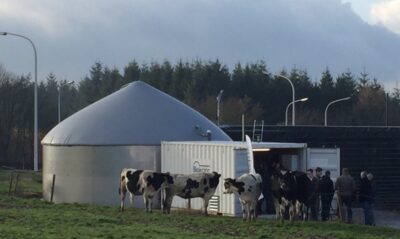
An example of a biogas digester facility.
After over ten years of R&D with small scale biogas systems, the Dickinson College Farm is going big and building a farm-scale digester that will convert our waste into electricity! This initiative began in 2018 with a feasibility study. Our project gained support of the USDA Natural Resource Conservation Service with a generous cost-share grant in 2020. From there things really picked up steam with project development and fundraising to pull it all together. Our expected completion time is autumn of 2023. Watch this space for periodic updates on the progress of this exciting, innovative project!
Background: We’ve been making burnable biogas from cattle manure and food waste in our pilot scale (1000 gallon) digester since 2015. This system consumes only 150 lbs of food waste per week at full capacity, yet it already can produce more gas than we need for cooking and canning on the farm. Given that the College dining hall produces about 750 lbs of food waste per day, we knew we would need to convert the biogas into a more transferrable form of energy if we upsize to a full-scale project. By coupling a biodigester with a combined heat and power (CHP) generator, we can convert our biogas into electricity and heat. This electricity can be used on the farm or sold back to the utility (like a grid-tied solar project). However, while 750 lbs per day is a lot of food waste, it is not quite enough material to power the smallest commercially available grid -tied CHP system. So we started looking around for more waste in the neighborhood.
Through our feasibility study, we identified Triple L Farm dairy as a perfect partner for a shared digester. The Hoover and Charles families have rented the property directly adjacent to the College farm from Dickinson for over 20 years. Triple L Farm keeps about 150 dairy cattle on the property and expressed an interest in working with us to turn their waste into energy and fertilizer. Engineers from the USDA NRCS identified some manure management concerns at the dairy farm that made the project eligible for federal conservation funding, in the interest of improving water quality in the Yellow Breeches Creek nearby. The dairy farmers are excited to have a modernized barn to house their cattle, an improved manure system, and free bedding from extracted manure solids which will lead to substantial cost savings over conventional bedding.
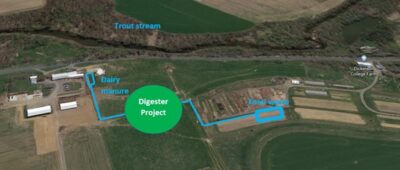
Basic overview of digesters planned location.
Our feasibility study and discussions with our dairy neighbors, USDA engineers and experts in the digestion industry has resulted in the following plan:
We’re building a new structure that will serve as combined dairy cow housing and waste collection & processing system. The dairy farmers will push their manure into a collection pit each day, then College Farm staff will take over waste management from there. Food waste will be delivered to the site daily, chopped and mixed in a separate pit before blending with the dairy manure. The combined manure and food waste slurry will be pumped to the digester for processing into biogas and digestate (liquid fertilizer). Liquid effluent from the digester will flow back to the cattle & waste building, where it will be passed through a screw press to remove manure fibers which will be used as cow bedding. The liquid fraction of the effluent will flow to a final storage tank to await spreading on the fields or addition to compost piles. Biogas from the digester will be fed to a 50kW CHP engine which will produce electricity and heat. The heat will keep the digester warm through winter months (they operate best at cow body temperature, about 100F) or be used to heat greenhouses and dry grain and vegetables. Electricity will be used to power all machines on the project site, with excess sold back to the Met Ed utility. We anticipate energy output of 200-300,000 kWh per year of clean renewable electricity. To optimize productivity of the system we are seeking additional food waste from the Carlisle community and have thus far secured an additional 2000-3000 lbs per week of external waste from the local food bank, a commercial bakery, a restaurant and a craft brewery.
Overall beneficial attributes of this project include reduced manure odors, reduced water pollution through modernized manure management, reduced loading of landfills with food waste, and reduced greenhouse gas emissions. All the while we will generate renewable, carbon negative electricity, revenue for the farm, and strengthen the farm economy in the Cumberland Valley.
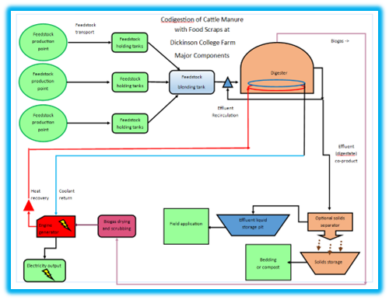
A flow chart detailing the process of the digester.
What makes our project especially exciting and unique is its modest scale. While 150 cows and 4000 lbs. per day of food waste seems like a lot to us, this is actually a small system as commercial biodigesters go. In the US most digesters are on farms with 500 or more cows due to economies of scale. However, in Europe, smaller “pocket digesters” have been proven effective on farms with herds as small as 50 cattle. So we are working with experienced Pennsylvania based manure management partners to build a smaller custom digester using domestic and European components. When complete, ours will be the smallest commercial digester in Pennsylvania. We will use this showcase system to teach and inspire farmers from around the mid-Atlantic to consider adding a small digester to their operations. There are about 5000 dairy farms in PA, with an average size of 85 cows. So the success of our project should pave the way for a lot more waste to energy digestion in our area.
Because we are building a lot of new infrastructure (cattle barn, waste pits, digester, final manure storage tank, new electrical service, new service road), our project will be costly with an expected total price tag of $1,600,000. Thankfully projects like this are eligible for lots of state and federal agricultural conservation incentive programs. To date we have secured over $1,300,000 in grants, donations and internal College funds to support development of the project. We are actively fundraising to complete the project – interested donors should contact collegeadvancement@dickinson.edu or the farm at farm@dickinson.edu. The expected completion date of the digester project is autumn of 2023.
Food Waste Diversion
While most farms digesters run livestock manure, “co-digestion” has proven to be more effective and provide more burnable gas. Co-digestion is when multiple types of organic matter such as manure, food waste, or plant matter are digested in the same biodigester together. With this in mind, the digester can be used as a mean to divert food waste from landfills. Currently the farm collects 700 pounds of cafeteria waste every day as well as X pounds of food waste weekly from various establishments in the Carlisle, PA area with the goal of collecting X pounds for the commercial digester.
The goal of food waste collection is to divert organic matter from landfills, where they will release methane into the atmosphere and where their nutrients will be lost and become unviable for future usage in biogas but also in agricultural systems. Biogas is made up of carbon, hydrogen and oxygen, while the important plant nutrients needed for composting (nitrogen, phosphorus, potassium and trace elements) are passed through the system and come out in a more bioavailable form for future usage in agriculture.
Education and Outreach
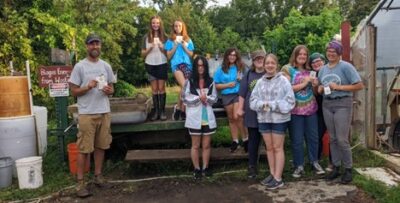
Local girl scout troop visits the farm’s small biodigester to learn about food waste diversion and renewable energy.
A critical function of the farm’s biogas program is our education and outreach initiative. Since 2008 we have worked to inspire students of all ages through demonstration of sustainable organic waste recycling into energy and fertilizer. Beginning with plastic jugs of sheep manure in the farmhouse basement, we have progressed through several iterations of lab and homestead scale anaerobic digestion systems, all built by farm students and staff. At present we maintain a 1000-gal pilot-scale reactor for cooking fuel production, numerous lab-scale research units, and are in process of constructing a commercial-scale waste to electricity farm digester. These are used to educate Dickinson students and the public through lab exercises, hands-on internships, field trips and day camps for K-12 youth and clubs, farmer field days, and presentations at regional conferences. Our team is also available for direct support to teachers and school programs looking to add biogas and composting units to their curriculum. To support the in-person experiences, we also produce educational biogas videos targeted at audiences of all ages. Public education is fundamental to our objective of helping to increase deployment of biogas technology on farms, in schools and at homesteads across our region.
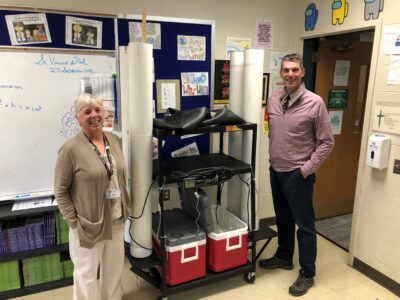
Teachers at St. Patrick’s School in Carlisle PA with a biogas experiment station designed by the Dickinson Farm project.
If you are a farmer, teacher, club leader, or student interested in learning more about biogas systems through tours, field trips, internships, presentations or virtual lessons, please contact project leader Matt Steiman for more information. The microbes and biogas await your inquiry!
Matt Steiman: E-mail steimanm@dickinson.edu
College Farm Education & Outreach coordinator: farmcoordinator@dickinson.edu
Research
Our ongoing research efforts have three components:
- Replicated lab-scale digestion for alternative feedstock analysis. In addition to cow manure and food waste, virtually all organic waste materials can be digested into biogas and fertilizer, so long as they are free of toxins and other contaminants. Combining multiple waste resources in one digester, known as co-digestion, can result in synergistic benefits such as diversification of the nutrients available to microbes and pH balancing, often resulting in higher levels of energy output compared to mono-substrate digestion. Taking advantage of locally available feedstocks enables a farm digester owner to increase revenue from additional energy generation as well as tipping fees for some externally produced wastes. Common questions facing digester operators are “what is the energy and nutrient value of a new feedstock”, and “what other operational impacts will occur if I add this feedstock to my manure digester?”. Establishing methane gas and nutrient production values for various feedstocks on a per kg basis is vital to successful extrapolation for planning and design purposes.
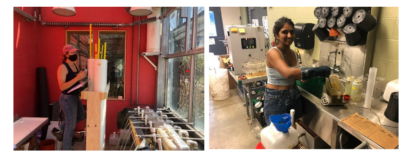
Figure 1: Analisa Groble ’22 (left) and Prerana Patil ‘24 (right) with the research digester set.

Figure 2: Average daily and cumulative gas production from 7.5 L continuous flow manure digesters (CM) and manure plus brewer’s grain (BSG) – n=3. Addition of brewer’s grain to digesters started on day 11. Note that the slope of the cumulative BSG line increases shortly after BSG addition began.
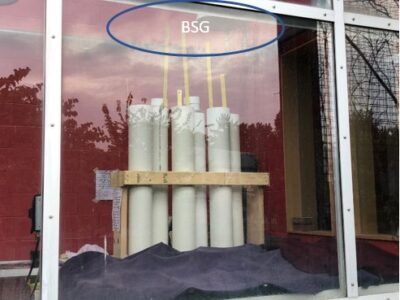
Figure 3: Daily gas collection from manure and manure with BSG digesters. Extended meter sticks are connected to 4” diameter tubular gas floats in the water-filled 6”cylinders seen in the rack – daily gas accumulation is read by noting the height of the meter stick above the rim of the base cylinder. The three highest sticks correspond to the BSG plus manure treatment replicates. This result has been typical since soon after the start of BSG addition to the daily feed mix.
We are now completing our third season of focused lab-scale anaerobic digestion research mostly focused on the value of brewers spent grain as an alternate feedstock. During this period we developed and refined an effective yet inexpensive apparatus for lab digesters that simulate larger-scale conditions. At the core of our apparatus are 2.5 gallon Fort-Pak type square plastic containers that we modify into semi-continuously fed mini digesters. We like this particular container because it can produce a functional AD system at a cost of only $20-25 per unit. The large volume (by lab digester standards) and 1” diameter fluid piping readily accommodate high solids blends of cow manure and food waste without significant clogging. Each digester is connected to a floating cylinder gas collector equipped with a meter stick for recording accurate gas volume data on a daily basis. Daily service of the digesters includes feeding, releasing digestate, and recording biogas production. Collected biogas is analyzed at least once per week to assess methane content. The experiments are run for about 100 days to generate data that reflect the long-term performance of novel feedstocks in a farm digester. For a more detailed view of the lab digester system, please visit our DIY Research Digester video on Youtube.
Students’ roles in this experiment were fabrication and troubleshooting of equipment, feeding and data collection, and physical and chemical analysis of feedstock and effluent under in the Chemistry lab. Physical analyses of materials included loss on drying and loss on ignition tests to establish % total and volatile solids, respectively. Chemical analyses included titration for alkalinity and testing for total nitrogen, total phosphorus, and chemical oxygen demand. The newly developed digester set is user-friendly, accurate, spill resistant and productive. In 2022 we built a second set of six digesters to test blends of brewers grain, cow manure and campus food waste.
Click here for a brief fact sheet on the brewers grain digestion project.
2. Digestate value as fertilizer: Liquid effluent (digestate) from the biodigesters conveys plant nutrients from the starting feedstocks broken down into a more bioavailable form through the action of microbial decomposition. While carbon, hydrogen and oxygen leave the system as biogas, nutrients important to crop growth (e.g. nitrogen, phosphorus and potassium) pass through the system and reside in the digestate. It is common practice for farmers to use digestate as liquid crop fertilizer. Our objective with this portion of the study is to assess the value of digestate as fertilizer for field and greenhouse crops using bioassays and crop nutrient analysis in the chem lab. This objective builds on a study conducted by Max Lee ‘19 in 2018.
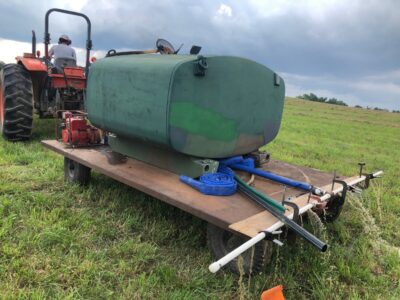
Figure 4: Field application of digestate via the pump wagon. This experiment did not yield measurable differences in grass growth.
We set up two pilot studies in 2021. The first involved field application of digestate from the farm’s 1000 gal pilot unit to pasture grasses using a pump wagon pulled by a tractor. To calibrate the field application we used a large rectangular tub of known area to catch and weigh a sample of digestate as the pump wagon was pulled through the pasture. These data allowed us to estimate the quantity of digestate applied per acre to the larger pasture. However after several weeks of grass growth, it was determined that no significant difference in grass growth was observed in comparison to an adjacent area where digestate was not applied.
In the second pilot trial, we planted kale seedlings in 1-gallon pots in the Stafford research greenhouse and applied the following treatments:
|
Treatment ID |
C-Control |
DE-Digestate |
DF-Digestate |
DG-Digestate |
P-Fish |
|
Fertilizer |
Water only |
1 digestate:2 water |
1 digestate: 3 water |
1 digestate: 6 water |
Commercial fish fertilizer |
Five replicate pots of each treatment were grown. Kale pots were checked daily and uniformly watered as needed. Once weekly all pots were fertilized with an equal volume (200 ml) of their designated treatment. This experiment was run for five weeks before we destructively harvested all kale plants. Plants were measured and photographed before placing them in freezer storage for further analysis for antioxidant content in the chemistry lab (this assessment will be carried out this fall). As seen in figure 4 below, the biomass production did not differ substantially between treatments. We suspect this was due to the quality of the potting mix used as a growth medium – note that the control plants which were not fertilized at all did not appear to suffer substantially due to lack of nutrients. We intend to repeat this experiment in the fall and spring semesters using a more nutrient-poor growth medium. A difference in concentration of antioxidants in the kale tissue may be discovered upon further testing in the chem lab later this fall.

Figure 5: Greenhouse grown kale plants fertilized with no fertilizer (control), liquid fish fertilizer (P) and three dilutions of digestate. Biomass growth and crop health did not differ substantially between treatments.
The digestate as fertilizer trial was repeated in 2022 using red russian kale and beets as test crops. In this experiment we used a more nutrient-poor growth medium and only dosed the potting mix with digestate once prior to planting. From that point forward all pots were moistened only with tap water. Kale plants grew successfully under this system. Currently the harvested biomass is in frozen storage for analysis in the chemistry lab to assess differences in plant nutrient content across the treatments.
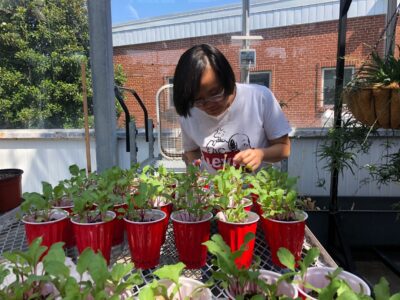
Uyen Nguyen tends pots of beets grown in diluted digestate from the biogas system in 2022.
3. Impact of diversion of food waste to digesters on existing composting program. The majority of campus food waste collected is currently processed through a farm-scale composting system with the resulting compost used as a soil improving amendment in vegetable fields. A third set of experiments seeks to assess the impact of routing the food waste through an anaerobic digestion system for energy extraction before the nutrients are added to leaf compost piles as digestate. The results of this study will help us predict future impacts on the farm while potentially guiding other commercial composters who may consider adding a digester to their food waste recycling program. This study also continues the work of Max Lee ’19 from the 2018 summer research period.
We set up two sets of compost experiments in 2021. In each experiment, three replicates of 1 m3 compost piles were built for each treatment – Food Waste (FW) piles containing leaves, compost seed material and campus food waste, and Digestate (D) piles containing leaves, seed material and digestate. Food waste was added to the FW piles on the day of pile construction, while digestate was added to D piles at regular intervals throughout the experiment. The gradual addition of digestate was necessary to prevent liquid saturation of the D piles. Each time digestate was added to D piles, an equivalent amount of water was added to FW piles to control for moisture addition. Temperature of all piles was recorded three times per week throughout the summer, and piles were turned manually at regular intervals. When compost piles were deemed near to maturity (no longer heating up after turning) their CO2 respiration and ammonia production were measured using SOLVITA colorimetric compost testing paddles (Woods End Laboratory, Mt. Vernon, ME). At the end of the experiment a seed germination bioassay was run on the finished composts to assess suitability for use as potting soil.

Prerana Patil builds the digestate composting research piles in 2021.
The first round of this experiment yielded promising results that align with our expectations for compost behavior (the second round is still underway). While the FW piles attained higher average temperature than D piles during the initial weeks of composting, this pattern flipped in the latter weeks of the trial. This is likely explained by the timing of nitrogen addition. N is a limiting nutrient for microbial growth and is typically balanced with carbon at a ratio of 30C:1N in an ideal compost pile. The leaf base of our composts is mostly carbon, while N is applied as either food waste or digestate. Since the FW piles received their N allotment in the initial construction, it makes sense that they would heat up early, while D piles had their N dosed at intervals throughout the trial and thus maintained moderately high temperature for a longer period while the FW piles cooled off after exhausting their supply of nitrogen. No difference was seen between the finished piles using the SOLVITA testing paddles (both treatments displayed characteristics of normal maturing composts). Likewise there were no substantial
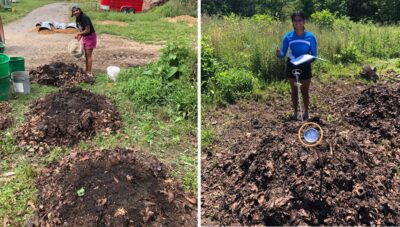
Figure 7: Prerana Patil adding digestate to D compost piles (left), recording compost temperatures (right).
differences in germination rate of three crops (corn, bean, radish) between the FW and D piles, but both treatments exhibited faster germination response than seeds grown in a commercial potting soil control (fig 7).

Figure 6: Germination bioassay of composts. Note performance of digestate compost (left) and food waste compost (right) exceed the commercial potting soil (center) seeded on the same day.
While we had some experiments in 2021 that did not yield the results we expected, all efforts did add substantially to the experience of our team. As we continue to gain proficiency with the materials, equipment and procedures used to assess the performance of anaerobic digestion systems and associated components at the farm, we are confident in our ability to achieve results that are of interest to operators in this field and ideally publishable in environmental engineering and chemistry journals.
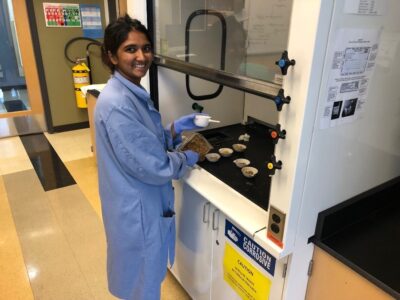
Figure 9: Prerana Patil prepares samples of brewers spent grain for total solid analysis in the chem lab.
Videos:
For K-12 audiences – intro to biogas and compost:
For science classes and interested farmers:
Build your own research digester:
For dairy farmers:
Beer to Biogas initiative:
Earlier versions of our project:
Papers and Articles:
If you want to dive deeper into biogas, here’s a list of papers and articles:
- Bucknell U. Digester Performance Study 2016
- Large Digester Feasibility Study 2018
- Digestate Research – Max Lee 2018
- Digestate Research – Full Paper
- Dickinson Digester Sustainability Analysis 2020
Current Initiatives:
Commercial Digester Updates:
April 11, 2023
Construction has begun!!
We are so very excited to share the news that construction work has commenced on the farm-scale digester system. After almost five years of planning, fundraising, permitting and design work, we have finally broken ground on the overall project site. Phase one, which includes the new dairy barn with collection and blending pits for the cow manure and food waste, should be complete by June 30th. Our educational pavilion will also go up by the end of June. The second phase, to include the digester and final manure storage tanks, will proceed early this summer. The final phase (installation of the digester cover, combined heat and power genset, and all mechanical and gas connections) will wrap up this coming winter.
We’re grateful to all of the people, firms, agencies, and funders who have helped us reach this exciting point in the project. Please stay tuned for more updates in the near future! Here are a few photos from the start of phase one:
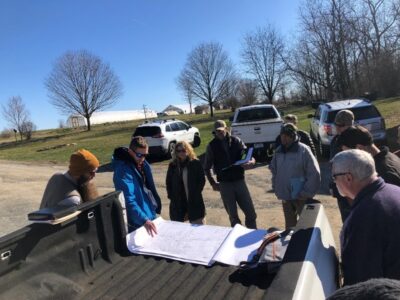
Figure 1: Preconstruction meeting with all main contractors and local authorities
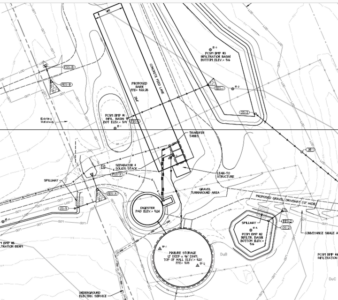
Figure 2: The updated plan set showing barn with waste collection pits to north, digester and manure tank to south

Figure 3: Weaver Hauling and Excavating gets the site laid out and begins stormwater infiltration basins
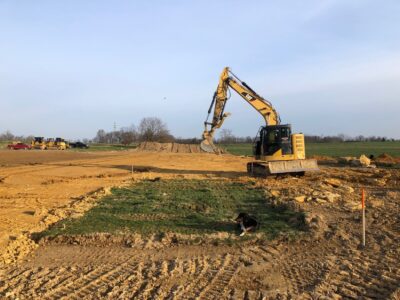
Figure 4: This pic shows the barn site from the south, with the area for the waste collection pits about to be dug.
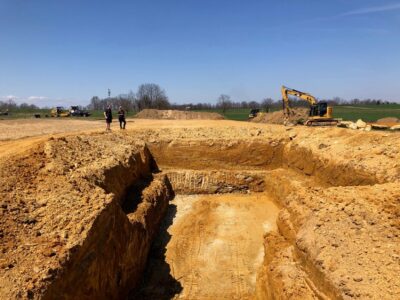
Figure 5: The waste collection pit in progress.
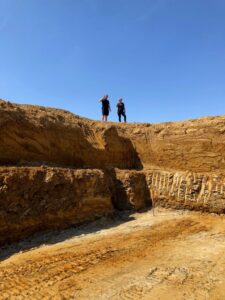
Figure 6: This 12′ deep pit will be the site for staging and blending of food waste with dairy manure.

Figure 7: Dickinson Farm team lends a hand with construction of this EPDM liner. Materials graciously donated by Carlisle Syntec roofing manufacturer.
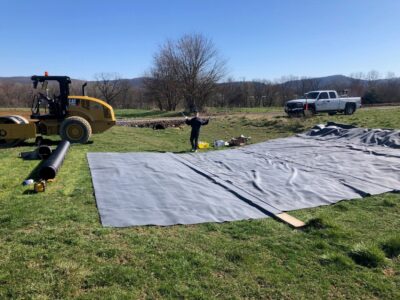
Figure 8: We will build three of these liners for the project. This one is 40’x24′.
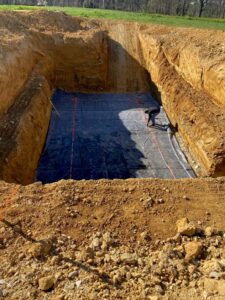
Figure 9: The first liner is in place in the waste collection pit. The purpose of the liner is to collect any leachate in the unlikely event of a tank leak. An observation and pumping well will be installed on the edge of the liner to monitor tank performance.
June 2023 Update:
Digester Construction Update June 28, 2023
Wow it has been a busy couple of months at the construction site! So much has been happening but we’ve been running hard just to keep up with project management and spring duties on the farm. Finally we’re getting a few rainy days and so are happy to update our construction page here on the blog. We are very happy with and grateful for all of the contractors who have brought their expertise and hustle to pull the project together. It is such a pleasure to work with all of these fine folks:
- Team Ag Engineering – site engineering, permits and project certification
- Barton Associates – electrical engineering and permits
- Weaver Hauling and Excavating – digging holes, grading, building roads, hauling rock, installing pipes
- Franklin Builders – Barn and pavilion structures, fixtures and concrete work
- Kurtzcrete – concrete tanks in the waste reception facility
- DML Poured Walls – round tanks for manure and digester
- Nutrient Control Systems – manure pumps, mixers, and digester kit.
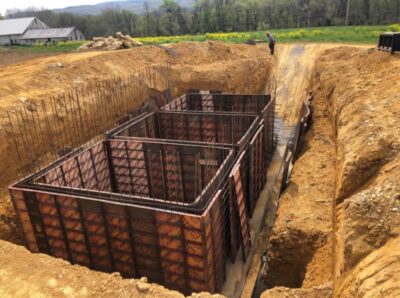
Forms are set and reinforcing bar installed for the waste reception tanks.

This group of enthusiastic students from the Big Spring Future Farmers of America visited the project site on the day of
our first concrete pour.

These 10,500 gal capacity concrete tanks are the core of the waste reception, processing and blending area.
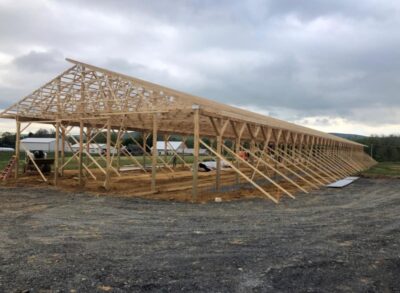
Once the tanks were done, the pro barn construction team from Franklin Builders put together this 285’ x 49’ structure
in about two weeks. They were flying! The completed barn will house both the dairy cattle and the waste reception and
processing area.
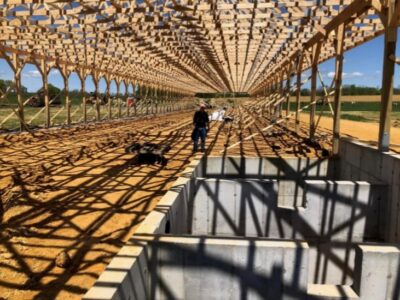
The waste reception area is contiguous with the dairy barn (separated by a concrete wall) to make efficient use of
materials and space.
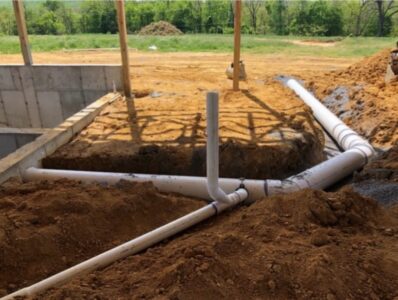
PVC piping installed by Weaver Hauling and Excavating. These pipes from tanks to the digester and digestate storage
tank were pressure tested and inspected before installation of the concrete floor slab.
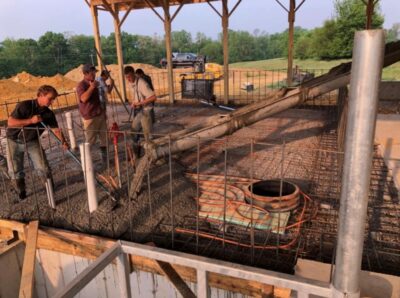
We installed PEX tubing to create a radiant heated floor under the mechanical room to protect equipment from freezing.
The tubing and floor will be heated by excess energy from the biogas waste to electricity generator.
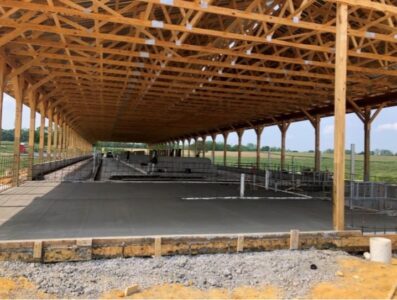
Floor slab installation before divider walls and control/mechanical room. White vertical pipe at right is one of two
observation wells for leak detection.
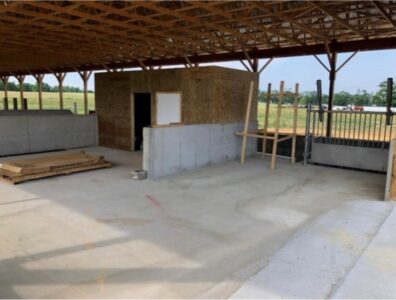
Slab, divider walls, and control/mechanical room installed. Metal structure at right is “push off guard” for loading of
bulk food waste into pits via tractor loader. The temporary wooden stand between room and push off guard is the
future site of the commercial food waste grinder.
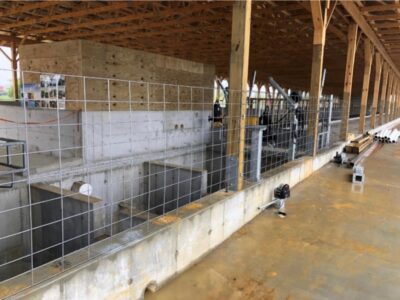
Waste reception area from outside with safety fence and some manure pumps installed by Nutrient Control Systems
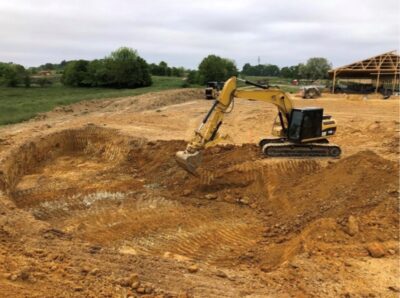
Meanwhile, nearby the expert machine operators from Weaver Hauling and Excavating dug another giant hole that
would become the final liquid storage tank for materials after digestion. It might not look that exciting from the pictures
but we really appreciated the skilled craftsmanship needed to dig a 96’ diameter round hole, 12 feet deep. Just knowing
where to put all of the soil a challenge in itself! They also hit a substantial amount of limestone.
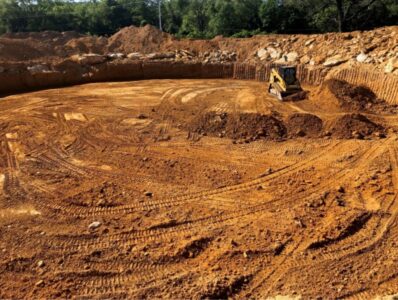
This pit was engineered to be a specific height in relation to the barn and waste collection area. The base was then lined
with clay to ensure a stable surface for the tank bottom.
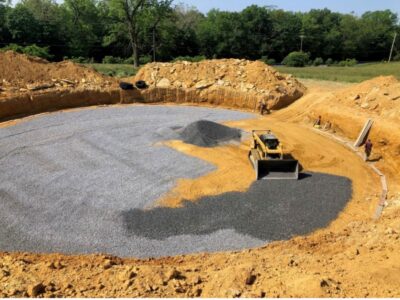
A stone base and footer drain pipe are laid in place before the reinforcing rods are installed.
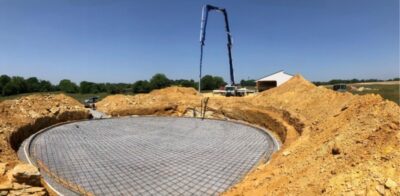
The crew from DML Poured Walls has rebar installed on the tank floor and concrete truck is ready to pump. We could
see this pumper crane from across the farm!

It was a long hot day of pouring and leveling concrete in the fishbowl for the guys from DML.
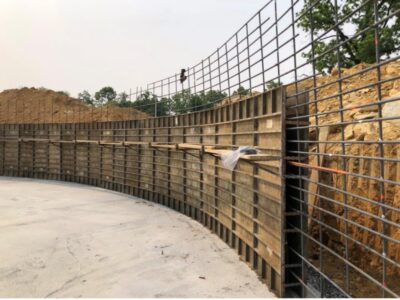
Once the floor had set, the DML crew constructed these walls with forms and rebar according to the engineer’s plans.
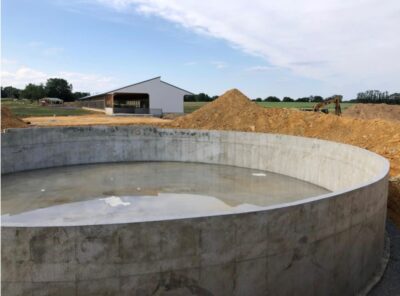
The completed tank had to cure for two weeks before backfilling the walls.

The farm crew had a little fun with graffiti before the big tank was backfilled!
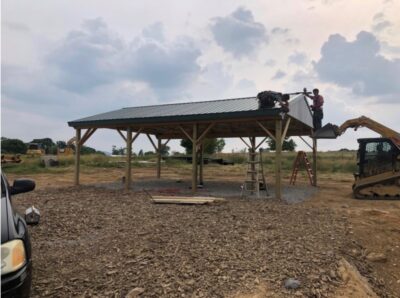
This pavilion will be the future gathering site for public tours and educational visits. Franklin Builders put it up in two
days!
That’s where we stand as of the end of June. Keep an eye out for more updates as we proceed to build the digester tank
and start installing mechanical equipment. Thanks for reading!!!
Biodigester construction update: November 2023
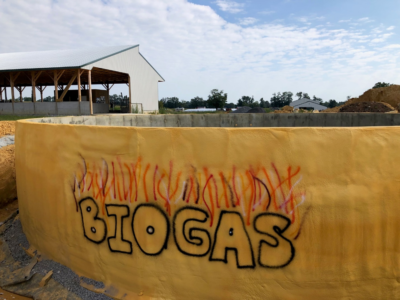
Wow, we’ve been busy since our last update. Between loads of construction management activity and the rigors of the farming season, it has taken us till the cooler days at season’s end to find time to update this blog! Our work since June can be summarized as follows:
· Completion of the free stall barn and waste processing area, including the solids separation room
· Completion of the educational pavilion
· Installation of pumps, mixers, solids separator food waste grinder and conveyor
· Construction of the digester tank
· Installation of bells and whistles on the digester tank: insulation, heat pipe network, pump, mixer, biogas collection system and cover
· Construction of the power shed pad and installation of the custom power shed
· Installation of the high efficiency fans for cattle cooling
· Installation of buried lines for fluid transfer, water service, electrical, and biogas flare
· New electrical pole with 3 phase service from the Med Ed utility
· Major site work including road and parking area construction, tank excavation, backfill, grading, seeding and storm water management
At this point most of the major construction items are complete! Electrical work is in progress. The last technical item to be installed is the combined heat and power engine that will convert our biogas into electricity and heat for the digester. The CHP engine is due to arrive in December. We expect pipefitting and electrical work will take another month at least. Our hope is to move cows into the free stall barn in January and commission the digester in February of 2024. Every day this target is one day closer! We can’t wait to start loading food waste and dairy manure into the digester to get everything rolling.
Our outreach efforts ramped up in the fall with numerous tours for farmers, ag professionals, college students, k-12 school aged youth and an international delegation. We set up the educational pavilion as an outdoor classroom with whiteboard and some hands on lab demos. This has been a big hit – we’ve had at least ten tours and counting since September. Please spread the word – we are open for educational visits for anyone by appointment. Our goal is to increase awareness of the benefits of food waste recycling through compost and biogas systems, as well as responsible manure management to improve water quality in the Chesapeake Bay watershed. If you would like to see the project in person just drop us a line at steimanm@dickinson.edu (Matt) or farm@dickinson.edu (farm office).
Please enjoy this photo tour of the work completed since June.
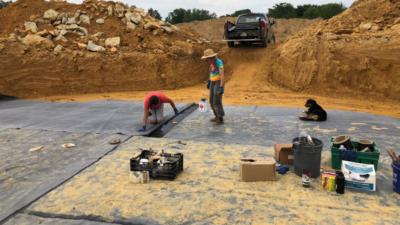
The farm crew building a liner under the digester tank. This was made from 45 mil reinforced EPDM membrane donated by Carlisle Construction Materials.
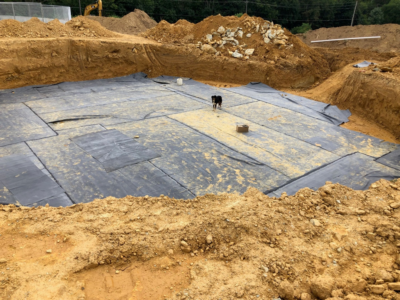
Pepe inspecting as the under-tank liner nears completion.
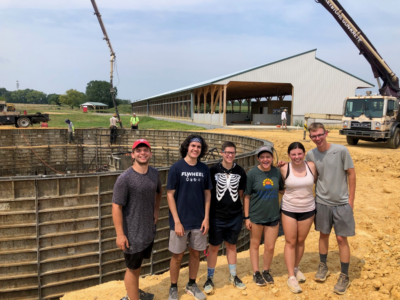
Dickinson pre-orientation students toured the digester site on the day the tank was built by DML Poured Walls.
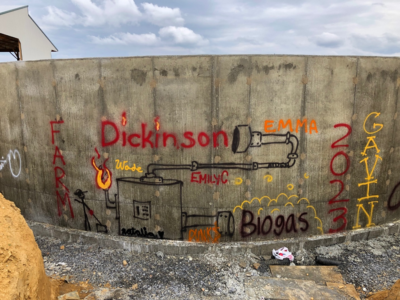
The farm crew couldn’t resist some graffiti on the digester tank before backfill!
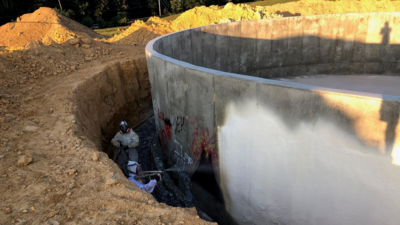
2” of insulation was sprayed onto the tank before backfill
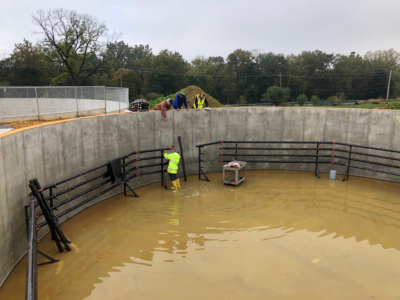
This custom network of 3” black iron heat pipes was installed in the tank by Tuckey Mechanical Services.
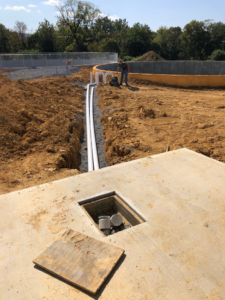
Brent from Weaver Excavating built the buried manure and food waste transfer lines from the waste processing barn to the digester. The two humps in the pipe near the tank are air vents to prevent syphoning. This picture also shows clean outs installed for pipe maintenance.
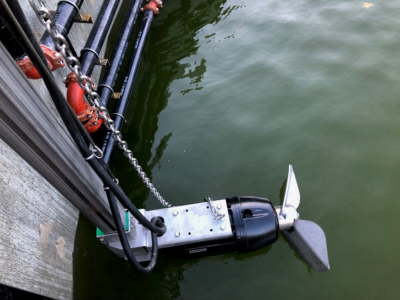
Nutrient Control Systems installed a heavy duty pump and mixer in the digester tank. Both machines can be winched to the surface for periodic service.
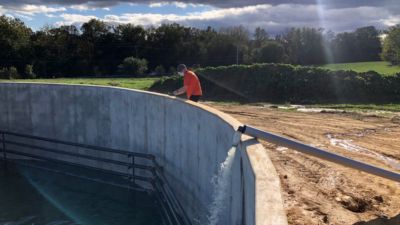
Once all internal components were installed, we filled the digester tank with 115,000 gallons of irrigation water. Student Zach Brown came in on a Sunday afternoon to help clean the tank rim before the cover installation team showed up the next day.
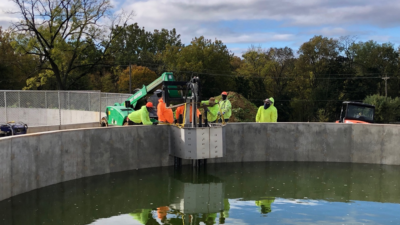
The “cover cowboys” from I.E.C. installed two of these hatch shrouds in the tank rim – one each for the pump and mixer. These protrude below the final water level of the tank, creating a gas tight port for machine service once the cover is installed.
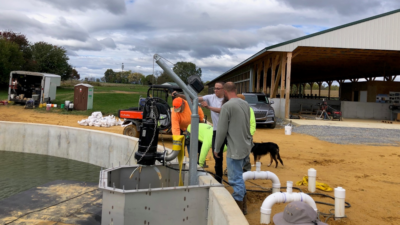
Student Zach Brown and Travis from Nutrient Control Systems working on the digester pump. This pump lives in the bottom of the tank and will push finished slurry (digestate) back to the barn pits for solids separation.
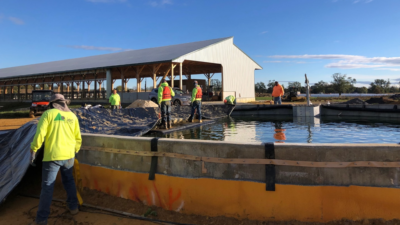
Cover guys from IEC pulling the membrane across the tank. They used a nifty floating raft to work in the middle of the tank. Note the final water level pump and mixer. This picture also shows the butyl rubber tape (tan color) and bolts around the tank rim that serve as the membrane attachment and seal.
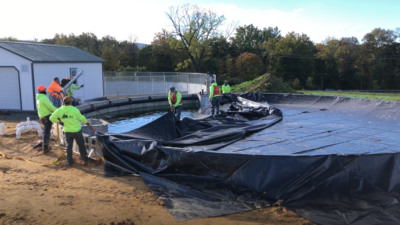
The cover was pulled across before being attached to the tank wall. The guys from IEC travel the country installing digester and manure lagoon covers. They were in and out of our site in three days – next stop – somewhere in the midwest.
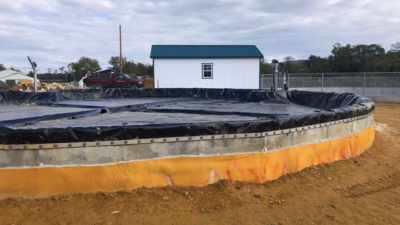
The completed cover, all sealed up. This picture also shows the custom power shed where the CHP engine will be installed to convert biogas into electricity and heat. The top of the cover includes insulation to maintain heat in the digester
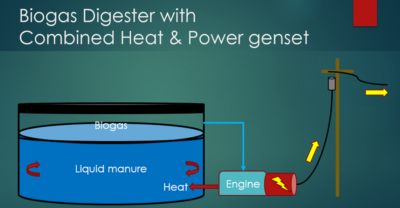
This conceptual diagram shows how the digester will interact with the CHP engine. The pump, mixer and heat pipes are not pictured.
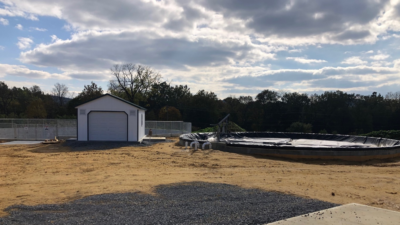
Our tidy little digester as the site comes together. To our knowledge at 115,000 gallons this is the smallest mechanized round tank farm digester in Pennsylvania.
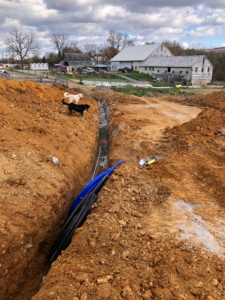
Pepe and Nina inspecting progress as Weaver Excavating installs the water lines and new road from the dairy farm to the digester site.

In late June, Franklin Builders completed this educational pavilion. Since then we have been using it as an outdoor classroom for student and adult education.
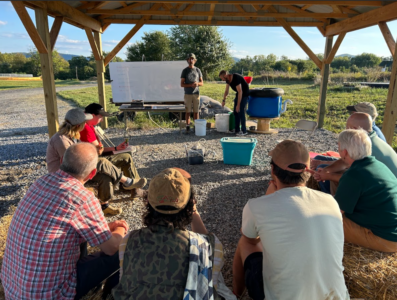
Farmers, teachers and ag professionals enjoying a biogas lesson in September
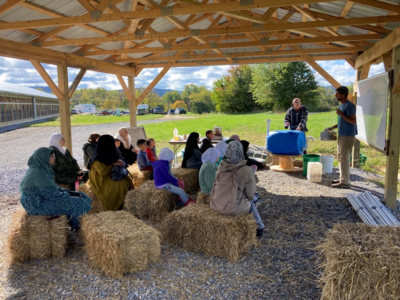
Students and parents from a local home school group engaged in a biogas lesson in the new pavilion in October.
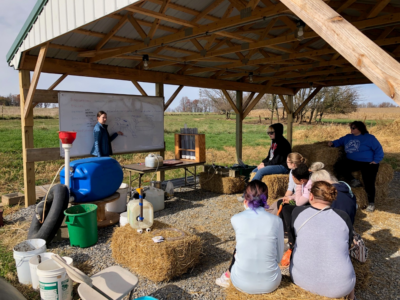
Dickinson student Kathryn Hickey teaches biogas science to a middle school class from the Yellow Breeches Education Center (YBEC).
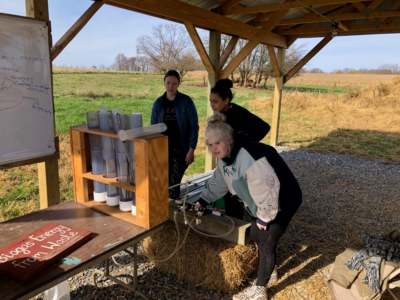
YBEC students get hands on with some biogas lab demonstration gear.
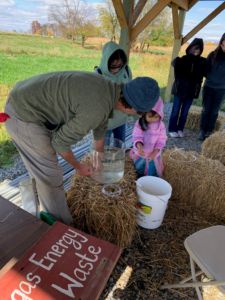
A youngster from the Harrisburg Area Homeschool Association learns to operate a syphon.
Biogas Spring Update:
Prior Digester Updates:
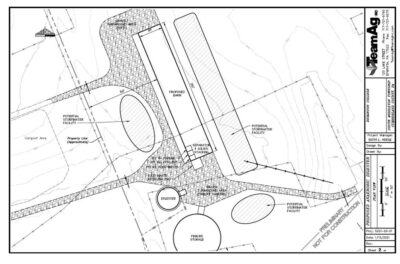
The updated blueprints for the Digester as of October 3, 2022.
10/3/22 Engineering for the digester project is virtually complete and the major hurdles are all behind us. Since 2020 we have been working with the excellent folks at Team Ag agricultural and environmental engineering. Team Ag has developed our civil engineering site plan and overall materials flow plan, as well structural engineering for the cattle barn and waste pits. This work was then used to secure site development and stormwater management permits from the PA Dept of Environmental Protection and to meet the standards of county engineers to ensure water pollution reduction in the nearby creek. Meanwhile we’re working with Barton Associates electrical engineers to develop a new service and interconnect agreement with the Met Ed utility as well as wiring plans for all buildings and major waste treatment components.
Experts from Nutrient Control Systems and Martin Energy have nearly completed the digester plan – we will post details in our next update.
Things are moving forward and we expect a ground-breaking ceremony late fall or early winter! Watch this space for another exciting update next month!
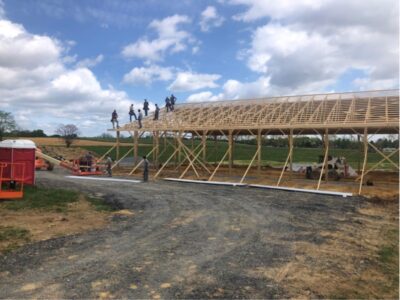
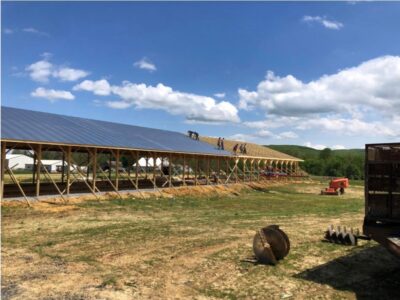
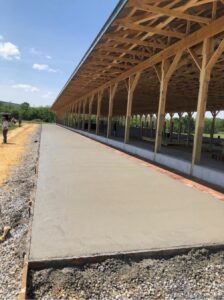

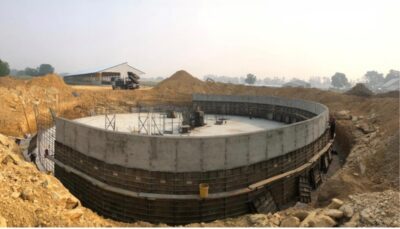
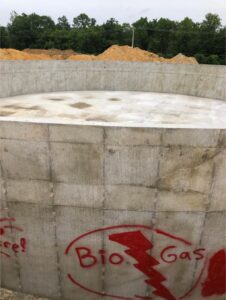
Leave a Reply